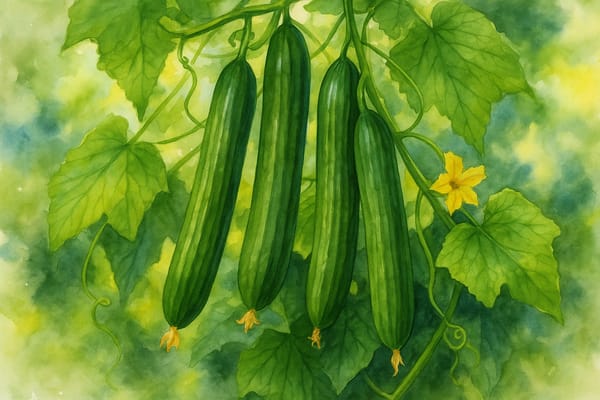There is something quietly luxurious about slicing into a homegrown cucumber on a warm July afternoon — the skin still cool to the touch, the flesh crisp and full of summer scent. Among the finest to grow for such a moment is Carmen F1 — an all-female, greenhouse-friendly cucumber that rewards attentive hands with a steady harvest of smooth, elegant fruit.
In Cornwall, where early warmth can be slow to arrive but summer days stretch long and moist under the glass, Carmen finds its ideal home. It’s a hybrid bred for resilience — resistant to common foes like powdery mildew and scab — and admired by growers for its ease, vigour, and superb flavour.
From Seed to Seedling: Starting Off Right
The journey begins in late February, when the garden is still dreaming. Sow Carmen’s seeds on their edge (this clever trick helps prevent rot), pushing them about 1cm deep into moist, free-draining compost in 7–8cm pots. A warm start is key — place pots in a heated propagator or on a bright windowsill, aiming for a gentle 20–25°C.
In a week or two, bright green cotyledons will unfurl. Once they emerge, remove any covering and ensure the seedlings receive good light — though not the full blast of spring sun. Rotate pots daily if needed, encouraging straight, balanced growth.
Potting On with Care
When each seedling grows its second set of true leaves, it’s time to pot on. Use a rich, open compost in 13–15cm pots, and handle gently to avoid root disturbance. Keep the soil evenly moist — never sodden — and offer a support stake early to encourage upright growth.
By May, with temperatures warming and days lengthening, it’s time to prepare for planting out.
Glasshouse or Garden? Choose the Setting with Intention
Carmen excels under cover — in greenhouses, polytunnels, or glass lean-tos — where warmth and humidity suit her Mediterranean temperament. But if your garden offers a warm, sheltered, south-facing pocket, she’ll also perform well outdoors when the danger of frost has passed (usually late May in Cornwall).
Before planting, harden off seedlings over 7–10 days, gradually introducing them to their new environment. Outdoors, prepare the ground with generous organic matter, ensuring rich, humus-laced soil with excellent drainage. Indoors or out, plant 45cm apart in borders or large pots. In grow bags, two plants per bag is perfect.
Be sure to provide support: strong vertical strings, wires, or canes. As plants ascend, tie in the stems gently and watch them climb.
Water, Feed, and Train: Encouraging Abundance
As Carmen begins to sprawl, her thirst will increase. Water regularly at the base — avoiding the vulnerable ‘neck’ of the stem — and consider sunken pots for direct, deep watering. In a glasshouse, dampen paths or floors on hot days to increase humidity and prevent leaf scorch.
Once the first flowers appear, begin feeding with a high-potassium liquid fertiliser (such as tomato feed) every 1–2 weeks to support fruiting. If growing in containers, feed earlier with a balanced fertiliser and switch to potash-rich feeds at flowering time.
Prune as needed: pinch out the growing tip when the main stem reaches the top of its support, and trim side shoots two leaves beyond any female flower (easily spotted by the tiny swelling of a cucumber behind it). Remove male flowers if they appear — Carmen is an all-female variety, and pollination can result in bitterness.
Soil Secrets: Give Her the Best
Like all cucumbers, Carmen is happiest in a fertile, free-draining soil that holds moisture without becoming boggy. A loamy or sandy loam, enriched with compost, is ideal. Aim for a pH between 6.0 and 7.0 — slightly acidic to neutral — to support healthy nutrient uptake. If the soil leans too acidic, add lime; too alkaline, and compost or well-rotted manure will help rebalance it.
Mulch the soil to retain moisture, but avoid direct contact with the stem.
Harvest Time: The Summer’s Yield
From early summer onward — around 10 to 12 weeks after sowing — cucumbers will begin to swell and elongate. Pick them young and tender, around 30–40cm long, using a sharp knife or scissors to avoid damaging the plant. Harvesting little and often, every couple of days, encourages more fruit to follow.
Best picked in the cool of morning, the cucumbers will be firm, fragrant, and crisp — a perfect addition to salads, sandwiches, or simply eaten sliced with salt and olive oil.
The Cornish Gardener’s Note:
There’s a joy in cucumbers grown under glass in Cornwall — a sense of nurturing something both delicate and generous. With Carmen F1, you’re not only growing food, but creating an atmosphere: warm, green, abundant. Whether tucked behind glass or basking in a warm walled garden, she brings the flavours of midsummer in every bite.
Let her climb, let her flourish, and she’ll give you more than you expect.











